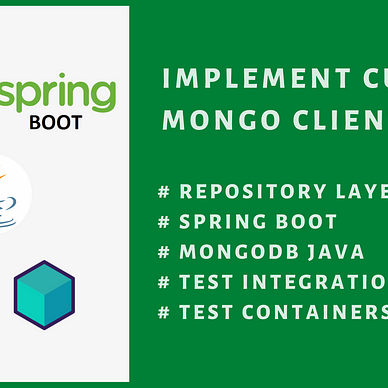Spring Boot Actuator
Let’s monitor Spring Boot applications
Hey guys! I’m back with another Spring Boot article 😎 If you missed the previous articles, here we go. 🙉



Spring Boot Actuator is sub module of Spring framework which enables the access to operational insights, metric of a running application. There is a bunch of endpoints already listed inside the module. We can even monitor CPU usage. JVM usage taking by the application. Not only that, we can get application information, database information, environment information also. We can setup the project to trace requests received to the back-end! 😮
Simply, we can create a monitoring application using these endpoints which is used by the internal teams.❤️
Setup Spring Boot Actuator
I will create a simple REST API project to demonstrate the things. I have connected MySQL database through JPA and hibernate in this project. Since actuator is coming with a starter dependency, we have to add it to the POM to get its functionalities.
<dependency>
<groupId>org.springframework.boot</groupId>
<artifactId>spring-boot-starter-actuator</artifactId>
</dependency>After adding this dependency and re running the project, you will see some log while application is starting saying that actuator is ready to use.
Visit here to check already enabled actuator APIs by default: http://localhost:8080/actuator. The default endpoint configuration is like this. Only few endpoints are exposed.
{
"_links":{
"self":{
"href":"http://localhost:8080/actuator",
"templated":false
},
"health":{
"href":"http://localhost:8080/actuator/health",
"templated":false
},
"health-path":{
"href":"http://localhost:8080/actuator/health/{*path}",
"templated":true
}
}
}Enable all actuator endpoints
We have to give a config property to enable all the other endpoints inside application.properties file.
management.endpoints.web.exposure.include=*.Then all the endpoints will be shown when we visit the actuator link.
{
"_links": {
"self": {
"href": "http://localhost:8080/actuator",
"templated": false
},
"beans": {
"href": "http://localhost:8080/actuator/beans",
"templated": false
},
"caches-cache": {
"href": "http://localhost:8080/actuator/caches/{cache}",
"templated": true
},
"caches": {
"href": "http://localhost:8080/actuator/caches",
"templated": false
},
"health": {
"href": "http://localhost:8080/actuator/health",
"templated": false
},
"health-path": {
"href": "http://localhost:8080/actuator/health/{*path}",
"templated": true
},
"info": {
"href": "http://localhost:8080/actuator/info",
"templated": false
},
"conditions": {
"href": "http://localhost:8080/actuator/conditions",
"templated": false
},
"configprops": {
"href": "http://localhost:8080/actuator/configprops",
"templated": false
},
"configprops-prefix": {
"href": "http://localhost:8080/actuator/configprops/{prefix}",
"templated": true
},
"env-toMatch": {
"href": "http://localhost:8080/actuator/env/{toMatch}",
"templated": true
},
"env": {
"href": "http://localhost:8080/actuator/env",
"templated": false
},
"loggers": {
"href": "http://localhost:8080/actuator/loggers",
"templated": false
},
"loggers-name": {
"href": "http://localhost:8080/actuator/loggers/{name}",
"templated": true
},
"heapdump": {
"href": "http://localhost:8080/actuator/heapdump",
"templated": false
},
"threaddump": {
"href": "http://localhost:8080/actuator/threaddump",
"templated": false
},
"metrics-requiredMetricName": {
"href": "http://localhost:8080/actuator/metrics/{requiredMetricName}",
"templated": true
},
"metrics": {
"href": "http://localhost:8080/actuator/metrics",
"templated": false
},
"scheduledtasks": {
"href": "http://localhost:8080/actuator/scheduledtasks",
"templated": false
},
"mappings": {
"href": "http://localhost:8080/actuator/mappings",
"templated": false
}
}
}Enable detailed Health endpoint
By default health endpoint will only contain the status only. if you go here: http://localhost:8080/actuator/health you would get response as this.
{
"status": "UP"
}It is not containing enough detail right? Now add the below config in your application.properties file to enable detailed API response for health.
management.endpoint.health.show-details=alwaysNow you will get a detailed view for health endpoint… 😎
{
"status": "UP",
"components": {
"db": {
"status": "UP",
"details": {
"database": "MySQL",
"validationQuery": "isValid()"
}
},
"diskSpace": {
"status": "UP",
"details": {
"total": 101057732608,
"free": 43956203520,
"threshold": 10485760,
"exists": true
}
},
"ping": {
"status": "UP"
}
}
}Enable Application Information endpoint
By default, /info endpoint is disabled in actuator. We need to add the below config to application.properties file to see application related information exposed by us.
management.info.env.enabled=true
info.app.name=Spring Boot Actuator Dashboard
info.app.description=Spring Boot backend to demonstrate actuator APIs
info.app.version=1.0So, after adding this visit here: http://localhost:8080/actuator/info to get application metadata.
{
"app": {
"name": "Spring Boot Actuator Dashboard",
"description": "Spring Boot backend to demonstrate actuator APIs",
"version": "1.0"
}
}Enable HTTP Trace endpoint
We can trace the application requests also using Actuator. But in recent versions of Spring Boot, it is disabled by default. So, we can enable that by adding the below config to application.properties.
management.trace.http.enabled=trueThis is not enough guys! 😛 We have add a bean configuration also in addition. You must add the below Configuration to the project. I have named the class as HttpTraceActuatorConfiguration.
package com.example.demoapp.configs;
import org.springframework.boot.actuate.trace.http.HttpTraceRepository;
import org.springframework.boot.actuate.trace.http.InMemoryHttpTraceRepository;
import org.springframework.context.annotation.Bean;
import org.springframework.context.annotation.Configuration;
@Configuration
public class HttpTraceActuatorConfiguration {
@Bean
public HttpTraceRepository httpTraceRepository() {
return new InMemoryHttpTraceRepository();
}
}Now, go and visit here: http://localhost:8080/actuator/httptrace. What do you see there? You should be having some kind of a response given below.
Now you can see all your requests in detail. Actually with these APIs, you can create an internally used monitoring dashboard front-end app for your back-end services 😍😉
Change actuator Base path
Add the below config in your application.properties file to change actuator endpoint path. This will replace http://localhost:8080/actuator with http://localhost:8080/manage.
management.endpoints.web.base-path=/manageCheck system related Metrics
We can get a lot of details about the running application using /metrics endpoints. If you go here: http://localhost:8080/actuator/metrics you will get all the metrics available.
{
"names": [
"application.ready.time",
"application.started.time",
"disk.free",
"disk.total",
"executor.active",
"executor.completed",
"executor.pool.core",
"executor.pool.max",
"executor.pool.size",
"executor.queue.remaining",
"executor.queued",
"hikaricp.connections",
"hikaricp.connections.acquire",
"hikaricp.connections.active",
"hikaricp.connections.creation",
"hikaricp.connections.idle",
"hikaricp.connections.max",
"hikaricp.connections.min",
"hikaricp.connections.pending",
"hikaricp.connections.timeout",
"hikaricp.connections.usage",
"http.server.requests",
"jdbc.connections.max",
"jdbc.connections.min",
"jvm.buffer.count",
"jvm.buffer.memory.used",
"jvm.buffer.total.capacity",
"jvm.classes.loaded",
"jvm.classes.unloaded",
"jvm.gc.live.data.size",
"jvm.gc.max.data.size",
"jvm.gc.memory.allocated",
"jvm.gc.memory.promoted",
"jvm.gc.overhead",
"jvm.gc.pause",
"jvm.memory.committed",
"jvm.memory.max",
"jvm.memory.usage.after.gc",
"jvm.memory.used",
"jvm.threads.daemon",
"jvm.threads.live",
"jvm.threads.peak",
"jvm.threads.states",
"logback.events",
"process.cpu.usage",
"process.files.max",
"process.files.open",
"process.start.time",
"process.uptime",
"spring.data.repository.invocations",
"system.cpu.count",
"system.cpu.usage",
"system.load.average.1m",
"tomcat.sessions.active.current",
"tomcat.sessions.active.max",
"tomcat.sessions.alive.max",
"tomcat.sessions.created",
"tomcat.sessions.expired",
"tomcat.sessions.rejected"
]
}You can see any of theses APIs using /metrics prefix with relevant metric name. The most important metric APIs to track:
http://localhost:8080/actuator/metrics/system.cpu.usage
http://localhost:8080/actuator/metrics/jvm.memory.max
http://localhost:8080/actuator/metrics/jvm.memory.used
http://localhost:8080/actuator/metrics/process.uptime
http://localhost:8080/actuator/metrics/application.started.time
http://localhost:8080/actuator/metrics/disk.free
http://localhost:8080/actuator/metrics/disk.total
http://localhost:8080/actuator/metrics/hikaricp.connectionsCreate a custom actuator endpoint 💥
We can create custom logic and return as a new actuator endpoint settled in actuator. There we need to setup a “@Component” with the relevant method logic. I named endpoint as “custom” using Endpoint annotation. It will be resolved later as http://localhost:8080/actuator/custom. The class name will be CustomEndpoint here.
@Endpoint(id = "custom")
@Component
public class CustomEndpoint {
@ReadOperation
public Map<String, String> customEndpoint() {
Map<String, String> map = new HashMap<>();
map.put("k1", "v1");
map.put("k2", "v2");
return map;
}
}I have just returned a dummy key value map in the code as the method logic. Then the endpoint will be listed inside actuator links as given below when you re run the application.
Visit the link and see the result….
{
"k1":"v1",
"k2":"v2"
}Update already available endpoint logic programmatically 💥
Actuator APIs can be accessed via the code also. It provides us the ability to do it in programmatic way also. Here I will take health endpoint and update its logic. Currently its response has this keys: db, diskSpace and ping. I’m going to add another key here..
There we need to access health endpoint interface and override the logic! I have created a new class called LoggerService. When this component is added to the health, it will take class name to setup the key to the response.
@Component
public class LoggerService implements HealthIndicator {
@Override
public Health health() {
if (isLoggingEnabled()) return Health.up().withDetail("logging", "Loggers are enabled").build();
return Health.down().withDetail("logging", "Loggers are disabled").build();
}
private boolean isLoggingEnabled() {
return true; // dummy - this is the place we need a proper implementation.
}
}Look at the response below. It has “loggerService” key in the response.
I think I have explained everything I know about Actuator. you can setup these endpoints in your Spring Boot micro services. Then you can see the application metrics easily. If you want, you can optimize the code then looking at the metrics like JVM usage / CPU usage.
Bye bye readers! Stay safe! ❤️
